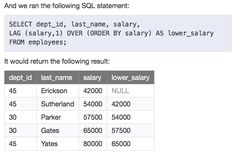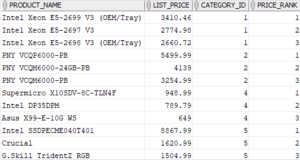Tag: PL/SQL
Oracle/PLSQL LAG function is an analytical function that allows you to query more than one row in a table, while not having an attached table. This returns values from the previous row in the...
Oracle/PLSQL FIRST_VALUE function returns the first value in an ordered set of values from the analytical window. It is similar to FIRST_VALUE and NTH_VALUE. Oracle/PLSQL syntax of FIRST_VALUE...
Oracle/PLSQL RANK function returns the value rank in the value group. It is very similar to the DENSE_RANK function. However, the RANK function may not return a consecutive ranking if the values...
Oracle/PLSQL CREATE TABLE operator allows you to create and define a table. CREATE TABLE syntax in Oracle/PLSQL CREATE TABLE table_name_id ( column1_id datatype [ NULL | NOT NULL...
The Oracle/PLSQL function DENSE_RANK returns the string rank in an ordered group of strings. It is very similar to the RANK function. However, the RANK function can cause an inconsistent ranking...
Oracle/PLSQL CUME_DIST function returns the cumulative distribution of values in the value group. The CUME_DIST function will return a value that is > 0 and <= 1. You can use CUME_DIST in...
Oracle/PLSQL COVAR_SAMP function returns selective covariance of a set of number pairs. Oracle/PLSQL syntax of function COVAR_SAMP COVAR_SAMP( expression1_id expression2_id )where:...
Oracle/PLSQL COVAR_POP function returns covariance of a set of pairs of numbers. Oracle/PLSQL syntax of COVAR_POP function COVAR_POP(expression1_id expression2_id )where:...
PL/SQL - Although SQL is easy to learn and has a lot of powerful features, it does not allow you to create procedural constructions that are possible in third generation languages like C....









